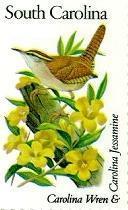
Carolina Wren
(Thryothorus ludovicianus)
Adopted in 1939.
Though the sabal palmetto is its most important symbol, South Carolina also holds birds in great esteem. Writing in Nature Magazine in 1932, state bird proponent Katherine Tippetts reported that the Carolina wren beat out the Carolina dove (eastern mourning dove) in a state bird campaign in 1930. The effort was led by Miss Claudia Phelps, of South Carolina's State Federation of Women's Clubs.
Prior to 1939 "The Carolina Wren" had been unofficially recognized as the State Bird of S. C. In 1939 the General Assembly passed an Act (No. 311) designating the Mockingbird as the official Bird of the State. Act No. 693, 1948 (1962 Civil Code, Sec. 28-2) was passed repealing the 1939 Act and designating the Carolina Wren as the official State Bird instead of the Mockingbird.
It is present in all areas in South Carolina from the coast to the highest mountain. The song; which may be interpreted as tea-ket-tle, tea-ket-tle, tea-ket-tle, tea-ket-tle; may be heard the year-round, day and night, in all kinds of weather.
The Carolina Wren is slightly smaller than an English Sparrow and has a conspicuous white stripe over the eyes. The back of its body is rufous-red with underparts somewhat lighter in color. The tail, which is finely barred with black, is held erect when the bird is excited.
Identification
- Length: 4.75 inches
- Long, thin, slightly decurved bill
- Bold white supercilium
- Rusty upperparts
- White throat and buffy underparts
- Wings and tail barred with black
- Thin white wing bars
- Long tail frequently held upright
- Pink legs
- Sexes similar
- Usually very vocal and loud
|
|
| Kingdom |
Animalia -- animals |
| Phylum |
Chordata -- chordates |
| Subphylum |
Vertebrata -- vertebrates |
| Class |
Aves -- birds |
| Order |
Passeriformes -- perching birds |
| Family |
Certhiidae -- creepers |
| Genus |
Thryothorus Vieillot, 1816 -- carolina wrens |
| Species |
Thryothorus ludovicianus (Latham, 1790) -- carolina wren, Chivirín de Carolina |